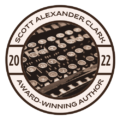After a bit of a hiatus, I’m back at it. Call it a mental health break, call it a creative block, call it a week from Hell, I had to put HVE on hold for a little bit. Brace yourselves, I’m about to get wordy.
The creative part that was really giving me fits was the new cover. We couldn’t use the old cathedral picture, and I found a replacement that I really liked, but we just couldn’t make the design work. It felt…amateur. I am an amateur, but I’d like it to look like I did more than MS Paint to make my book. Liz and I tried all manner of fonts, colors, positioning, block elements, and frames to get us to somewhere useful, but nothing worked. I had to walk away. Thankfully, we had Girl Scout Cookies to focus on. My back is killing me from the 212 cases of cookies we loaded and reloaded, since Liz was the coordinator for Lia’s troop. Then I banged up my car, had to get it in for service, got hit with a big estimate, and it was just a bad time.
Anyway, fast forward to bored Saturday. I figured I had nothing to lose by looking at it again, so I got into Canva and thought about what we’d done. I looked at some other cover templates and played around with putting the new images in frames. I got the font back that I really liked (It’s Voga, BTW), and what you now see on the site is what I came up with. It feels more real, marketable, pro. Liz touched up the back cover and a full design emerged, just in the span of a day.
Now, here’s where it got REALLY fun. IngramSpark is very particular about the formatting. They have a cover template generator, which is very helpful in that it calculates the spine size based on page count, and they also create a barcode for you (saved me $25 there). Problem is, it only outputs as PDF or InDesign format, and I have neither Acrobat nor InDesign. These rather expensive pieces of software are a bit out of my reach at the moment. A little searching (not Googling, I use DuckDuckGo) brought me to Emma Rosen’s great YouTube video about designing an IngramSpark compliant cover design in Canva. Game on.
To use her method, I tried Adobe Cloud, but they’re always trying to sell you on expensive monthly subscriptions. Yes, they’re the industry standard, and their products are worthwhile, but I just need to do one export one time. Shout to SmallPdf for allowing a couple high-quality conversions for free (2 per day). I finally got something that worked using all the bleed edges, a dark background (something Emma did not do with hers), and it looks like it ticks all the boxes. Obviously, I’ll have to submit it to Ingram to find out for certain. With the cover mostly sorted, I thought I’d take another look under the hood at the PDF text.
Wall. Of. Text. Ugh. Scrivener did a great job formatting everything for me, but it just felt all mushed together. The words needed to breathe. Since I had to update the EPUB with the new cover anyway, and I wanted to take some company names out of the text, I made a couple minor edits (< 10 words) and recompiled with a 6pt space after paragraph. Holy mother forking shirt balls. PDF went from 250pp to 278pp! That’s gonna wreck my cover design with a thicker spine. Liz said it looked too much like YA fiction, so I went back to the bookshelf and looked through some sci-fi and such. The text did seem to be at 1.0 (no spacing), but it didn’t make me happier. I compromised and dropped it to 2pt after paragraph. It’s a bit easier on the eyes without being absurd and it only added 8pp rather than 28.
Still, back to the drawing board I went. I had to adjust the Canva design by a fraction of a mm, but it was a quick fix and I’m still happy with it. I’ll likely let this sit for a bit and spend a bit of time with the family this evening. Perhaps, when I go on my mini-vacation to visit family later this week, I’ll take some quiet time and wrap this all up. It has been a wild ride the last two days, but I think the break paid off. If there’s one bit of advice I could give: It’s okay to let it sit for a couple days. We’re publishing books, not saving lives, and sometimes the creative process benefits from time and space. You owe this to yourself so that when you’re working on the things that matter, you’re always bringing your best to it.
